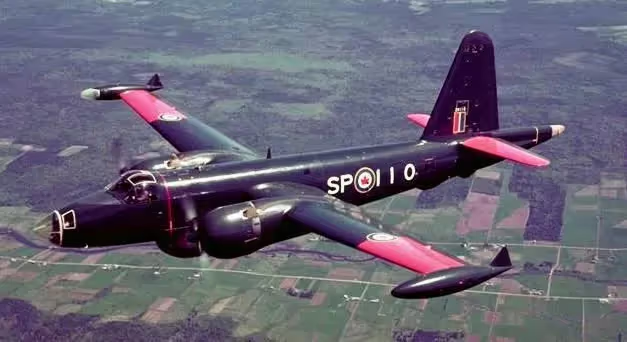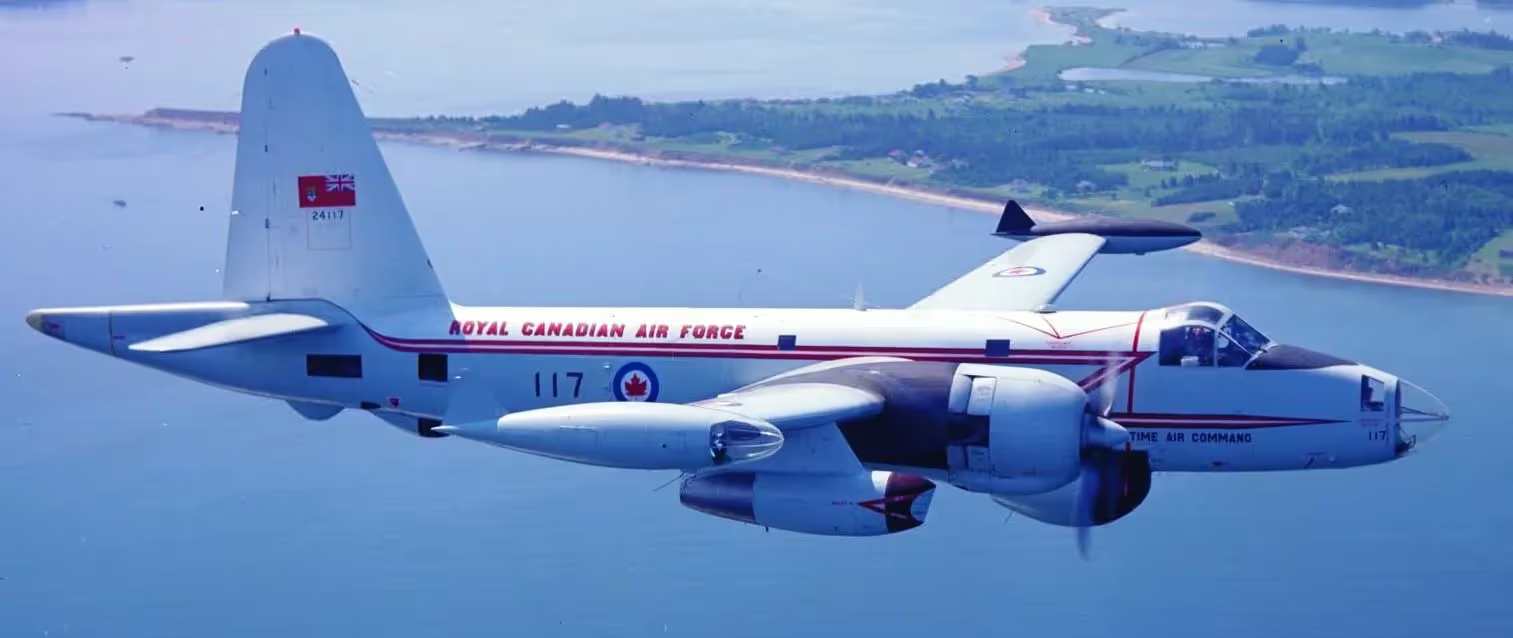Canadian Warplanes 5: Lockheed CP-122 Neptune
Lockheed CP-122 Neptune

(DND Photo via Mike Kaehler)
Lockheed CP-122 Neptune, RCAF (Serial No. 24120), over Halifax, Nova Scotia. The sea blue paint scheme came into use in the 1960s.
Lockheed CP-122/P2V-7/CL-826-45-14 Neptune (25), (Serial Nos. 24101-24125).
The Lockheed P-2V Neptune was a Maritime patrol and anti-submarine warfare (ASW) aircraft developed for the US Navy. The Canadian version of the Lockheed Neptune (P2V7) served as an anti-submarine, anti-shipping and maritime reconnaissance aircraft in the RCAF Maritime Air Command from 1955, replacing the Avro Lancaster maritime aircraft. The Canadian P2V7 was fitted with piston engines, although initially, in 1959, the Neptunes had two underwing Westinghouse J34 jet engine pods retrofitted, similar to those fitted to US Navy variants. Armament included two torpedoes, mines, depth charges, bombs carried internally plus unguided rockets mounted externally underwing. A total of 25 Neptunes served with RCAF Nos. 404, 405 and 407 squadrons until 1960. With the unification of the Canadian Forces in 1968, the Neptune was retired and retroactively re-designated the CP-122. The RCAF Neptune was replaced by the Canadair CP-107 Argus in the same year. (Wikipedia)

(DND Photo via Francois Dutil)
Lockheed CP-122 Neptune, RCAF (Serial No. 24101), coded VN. The Neptunes were delivered from the factory in a midnight blue paint scheme.

(DND Photo via Francois Dutil)
Lockheed CP-122 Neptune, RCAF (Serial No. 24101), CFB Greenwood, Nova Scotia.

(DND Photo via Francois Dutil)
Lockheed CP-122 Neptune, RCAF (Serial No. 24101), coded VN.

(RCAF Photo)
Lockheed CP-122 Neptune, RCAF (Serial No. 24102) over the West coast, operating from CFB Comox, British Columbiaé

(City of Vancouver Archives Photo, AM1376-: CVA 1376-330)
Lockheed CP-122 Neptune, RCAF (Serial No. 24102), flying over English Bay, British Columbia, ca 1950s.

(RCAF Photo)
Lockheed CP-122 Neptune, RCAF (Serial No. 24102).

(RCAF Photo)
Lockheed CP-122 Neptune, RCAF (Serial No. 24102).

(RCAF Photo via James Craik)
Lockheed CP-122 Neptune, RCAF (Serial No. 24104).

(RCAF Photo via James Craik)
Lockheed CP-122 Neptune, RCAF (Serial No. 24106).

(RCAF Photo via James Craik)
Lockheed CP-122 Neptune, RCAF (Serial No. 24106), coded SP.

(RCAF Photo via James Craik)
Lockheed CP-122 Neptune, RCAF (Serial No. 24106), coded SP.

(RCAF Photo via James Craik)
Lockheed CP-122 Neptune, RCAF (Serial No. 24106), coded SP, firing rockets.

(RCAF Photo via James Craik)
Lockheed CP-122 Neptune, RCAF (Serial No. 24106).

(RCAF Photo via James Craik)
Lockheed CP-122 Neptune, RCAF (Serial No. 24106).

(RCAF Photo via James Craik)
Lockheed CP-122 Neptune, RCAF (Serial No. 24106).

(DND Photo by Norm Fenerty c1960s)
Lockheed CP-122 Neptune, RCAF (Serial No. 24106), No. 404 "Buffalo" (MP) Squadron, Halifax, Nova Scotia. Note Dalhousie University and the University of King's College forward of the top wing tip. RCAF Station Goresbrook can be seen just under the nose. c1960s.

(DND Photo)
Lockheed CP-122 Neptune, RCAF (Serial No. 24106), No. 404 "Buffalo" (MP) Squadron. Later served with No. 2 (Maritime) Operational Training Unit at Summerside, PEI.

(DND Photo)
Lockheed CP-122 Neptune, RCAF (Serial No. 24106), No. 404 "Buffalo" (MP) Squadron over the Citadel in Halifax. 24106 later served with No. 2 (Maritime) Operational Training Unit (OTU), at CFB Summerside, Prince Edward Island.


(RCAF Photo via Mike Kaehler)
Lockheed CP-122 Neptune, RCAF (Serial No. 24106), No. 404 "Buffalo" (MP) Squadron.

(DND Photo via Mike Kaehler)
Lockheed CP-122 Neptune, RCAF (Serial No. 24110), coded SP, No. 404 (Maritime Reconnaissance) Squadron.

(DND Photo via Mike Kaehler)
Lockheed CP-122 Neptune, RCAF (Serial No. 24110), coded SP, No. 404 (Maritime Reconnaissance) Squadron.

(DND Photo via Francois Dutil)
Lockheed CP-122 Neptune, RCAF (Serial No. 24110), coded SP, No. 404 (Maritime Reconnaissance) Squadron.

(SDASM Photo)
Lockheed CP-122 Neptune, RCAF (Serial No. 24110), coded SP, No. 404 (Maritime Reconnaissance) Squadron.

(DND Photo via Francois Dutil)
Lockheed CP-122 Neptune, RCAF (Serial No. 24111).

(RCAF Photo via Mike Kaehler)
Lockheed CP-122 Neptune, RCAF (Serial No. 24111), No. 407 Squadron, RCAF, being loaded with torpedoes by a technician at RCAF Station Comox, British Columbia, in the 1960s.

(RCAF Photo)
Lockheed CP-122 Neptune, RCAF (Serial No. 24111).

(RCAF Photo via Mike Kaehler)
Lockheed CP-122 Neptune, RCAF (Serial No. 24112), at the Fairey Aviation Plant prior to acceptance by the Air Force. The bright colours replaced the former navy blue shade. This Neptune went to RCAF Station Summerside, Prince Edward Island, where it was used to guard Canada's East Coast from submarine threats.

(RCAF Photo)
Lockheed CP-122 Neptune, RCAF (Serial No. 24113).

(RCAF Photo)
Lockheed CP-122 Neptune, RCAF (Serial No. 24116).

(RCAF Photo via James Craik)
Lockheed CP-122 Neptune flight line.

(DND Photo via Mike Kaehler)
Lockheed CP-122 Neptune, RCAF (Serial No. 24117).

(RCAF Photo via James Craik)
Lockheed CP-122 Neptune, RCAF (Serial No. 24117).

(RCAF Photo via Chris Charland)
Lockheed CP-122 Neptune (Serial No. 24117).

(RCAF Photo via James Craik)
Lockheed CP-122 Neptune, RCAF (Serial No. 24119), in formation with Avro CF-100 Canuck Mk. 5 (Serial No. 18631).

(DND Photo via Francois Dutil)
Lockheed CP-122 Neptune, RCAF (Serial No. 24119), coded VN.

(DND Photo via Francois Dutil)
Lockheed CP-122 Neptune, RCAF (Serial No. 24119), coded VN, view of the flightline.

(DND Photo via Brian Rempel)
Lockheed CP-122 Neptune, RCAF (Serial No. 24120).

(Library and Archives Canada Photo, MIKAN No. 3585050)
Lockheed CP-122 Neptune, RCAF, cockpit, 4 Jan 1955.

(Peter Behring Photo)
Lockheed CP-122 Neptune, RCAF (Serial No. 24121).

(DND Photo via Chris Charland)
An RCAF Neptune (Serial No. 24121) and CP-107 Argus Mk. 1 at RCAF Station Summerside. No. 407 "Demon" (MP) Squadron at Comox, British Columbia, was the last unit to use the Neptune operationally.

(RCAF Photo via James Craik)
Lockheed CP-122 Neptune, RCAF (Serial No. 24123), equipped with jet pods and tip tanks. As the Neptune entered service, the on-board equipment made it heavier. The jets were used to help lift the aircraft into the air by providing more thrust. Because the jets made the aircraft heavier it required more fuel which in turn reduced the patrol time by a few hours. The jets did, however, give the Neptune much increased air speed whenever needed and could the crew could surprise Russian subs that were on the surface over the horizon by arriving much sooner than expected. The change from lumbering along on props only, to jet speed allowed them to catch the sub before it could submerge. These submarines were in international waters off the west coast when on the surface. The Neptune crews found a few in coastal waters testing our defence systems. The electronics on the Neptune were pretty state of the art in the cold war days. (Don Murphy)



(Author Photos)
Lockheed EP-2H Neptune, ex-USN (BuNo. 147969), c/n 7219, first flown by the USN in 1960, later Reg. No. N702AU. It has been on loan to the RCAF since it was flown to CFB Greenwood on 27 Aug 1980. This aircraft was initially painted dark blue to represent an RCAF CP-122 Neptune and marked as RCAF (Serial No. 24117). It was repainted in 2008 as RCAF (Serial No. 24101).

(RCAF Photo via Mike Kaehler)
Two Armaments Technicians, installing a practice bomb container in a Neptune aircraft. From left to right: Leading Aircraftsman (LAC) H. MacDougall and LAC W. Clark.

(RCAF Photo via Mike Kaehler)
LAC Real Henri, a Communications Technician, carrying out a Daily Inspection (DI) in a Neptune.

(RCAF Photo via Mike Kaehler)
Two Airmen putting rocket containers on wing of a Neptune.

(RCAF Photo via Mike Kaehler)
Two Technicians servicing the undercarriage of an RCAF Neptune. From left to right: Cpl Ron Mills and Cpl Len Robertson.

(RCAF Photo via Mike Kaehler)
Regardless of a jet engines size, they all require expert maintenance. Shown here performing a last minute "pre-flight inspection" is Aero Engine Technician Leading Aircraftman Richard Charles Dickeson. LAC Dickeson was serving at RCAF Station Comox as a member of No. 407 Maritime Patrol Squadron where he is shown here engaged in the maintenance and repair of P2V-7 Neptune patrol aircraft engines.

(RCAF Photo via Mike Kaehler)
Observer and Navigator at work in a Neptune. F/O Aubrey J. Hudson.





